Crape Myrtle: Care and Plant Growing Guide (With Pictures)

Crape myrtle shrubs and trees are beautiful garden landscape plants with stunning colorful flowers that bloom all summer long. Crape myrtles are excellent shrubs for growing beautiful flowering hedges, colorful borders, or attractive container plants. Small crape myrtle trees grow best as specimen trees or lawn trees to add vibrant colors to summer gardens.
Crape myrtle is a genus of deciduous and evergreen shrubs and trees in the genus Lagerstroemia. There are around 50 species of crape myrtle, and they are famous for their brightly-colored clusters of flowers.
Crape myrtle trees and shrubs thrive in USDA zones 7 through 9. Crape myrtles grow in warmer climates in the southern United States, Australia, and India.
This article is a complete guide to caring for crape myrtle trees and shrubs. You will also find helpful tips on planting and growing these stunning colorful shrubs in your garden.
What Do Crape Myrtles Look Like?
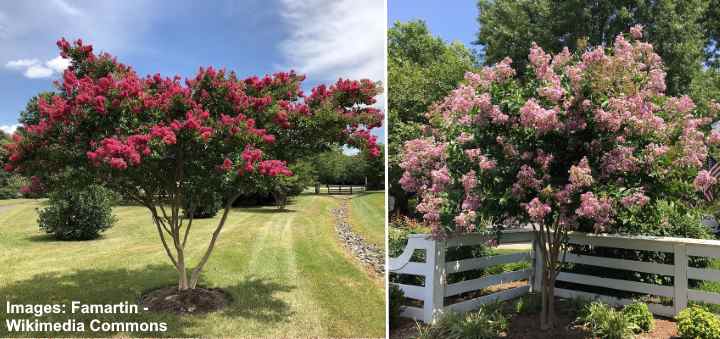
Crape myrtles are woody plants that can grow as large shrubs or multi-stemmed small trees
Crape myrtles are large shrubs or small trees with multiple stems and a rounded, bushy crown. Large flower clusters that bloom during summer are the plant’s most outstanding feature. Crape myrtles have smooth peeling bark in a range of colors including, gray, cinnamon, light tan, and soft pink.
Another feature of crape myrtle plants is their glossy dark green oval leaves. The large, broad leaves appear in spring as a dark red color before creating lush, dense green summer foliage. In fall, crape myrtles transform into warm shades of orange, yellow, and red.
Crape myrtles have plenty of year-long interest thanks to their colorful exfoliating bark, large flower clusters, lush summer foliage, and beautiful fall colors.
Crape Myrtle Colors
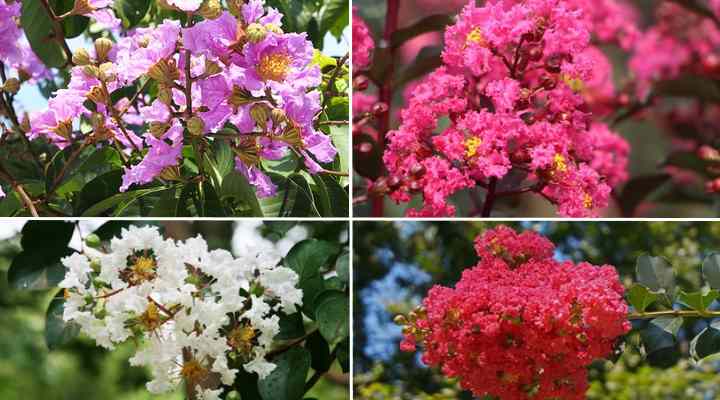
Crape myrtle flowers can be in shades of red, pink, purple and white colors
Crape myrtles are some of the most colorful shrubs and trees you can plant in warm climates. The large bushy shrubs produce flowers in vibrant shades of pink, lilac, red, and purple. However, some species also have white flowers and flower shades in gentle pastel colors.
The colors that crape myrtles produce includes more than just the flowers. New leaf growth in spring turns the bushy plants a rich red color. Then in fall, when the leaves change color, the dense shrub foliage turns shades of yellows, oranges, and reds before the leaves drop.
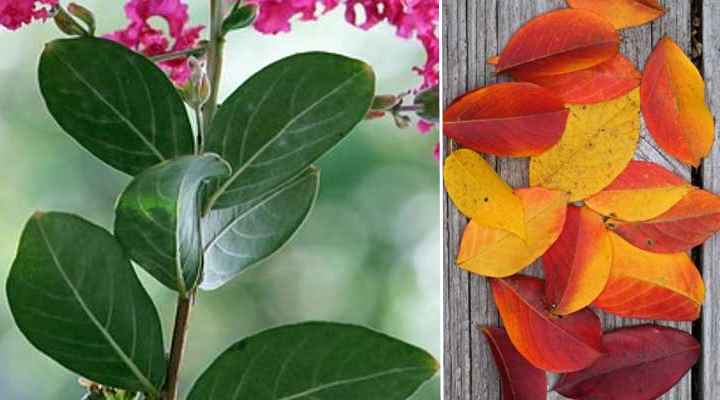
Crape myrtle leaves and autumn foliage (right)
The leafless branches allow you to see the attractive grayish-brown bark that peels to reveal cinnamon and pink colors.
Crape Myrtle Flowers
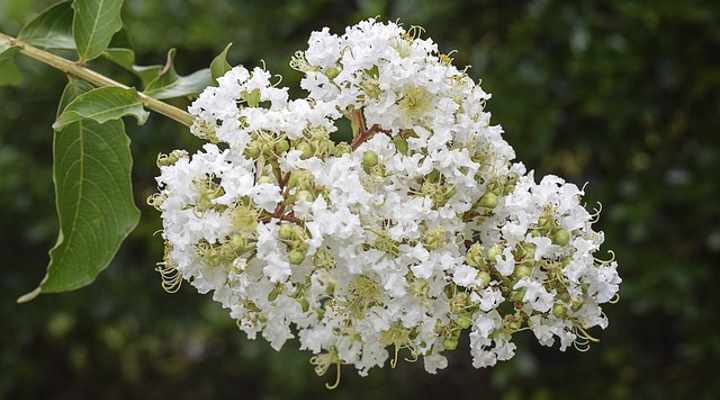
A close up picture of crape myrtle flowers
Carpe myrtle flowers are made up of tiny petals that look like crepe-paper growing in large clusters. Showy flower clusters called panicles grow between 6” and 18” (15 – 45 cm) long. When in full bloom, crape myrtle flowers cover the tree in shades of pinks, purples, lilacs, reds, and white. The crinkled petals give the flowers a ruffled appearance.
Crape myrtle shrubs and trees typically bloom from June. The flowers last throughout the summer until the end of September.
Crape Myrtles in the Garden and Landscape
Growing crape myrtle trees and shrubs in your garden is the perfect way to add beauty and color to landscapes. The long-blooming time of crape myrtle trees means you can enjoy their showy flowers for many months.
Depending on the type of crape myrtle shrub you plant, you can grow small flowering trees, colorful hedges, or use them to beautify mixed beds. Dwarf crape myrtle bushes are also ideal for growing in containers. You can place potted crape myrtle plants on balconies, patios, or deck areas to add greenery and color.
Here some popular ways to grow crape myrtles in gardens.
Crape myrtle shrubs for hedges and screens
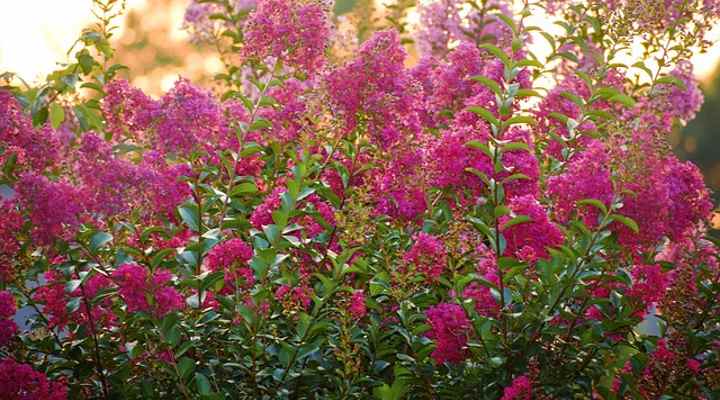
Crape myrtle shrubs are great as flowering hedges
Crape myrtle bushy growth means the shrubby plants are ideal as flowering hedges and dense privacy screens. Evergreen crape myrtles will also provide year-long privacy for your backyard. Plant crape myrtle shrubs around 4 to 6 ft. (1.2 – 1.8 m) apart to create a dense hedgerow. Prune thin woody branches every winter to encourage lush growth.
Some of the best crape myrtle hedge plants are ‘Catawba’ (Lagerstroemia indica ‘Catawba’), and ‘Tonto’ (Lagerstroemia indica ‘Tonto’).
Crape myrtle are beautiful specimen trees
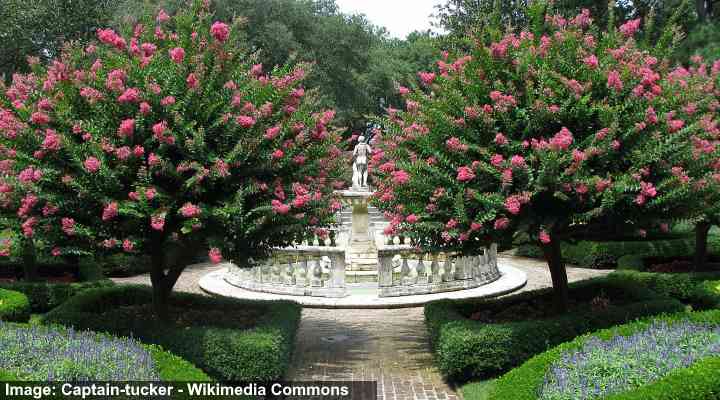
Crape myrtles are beautiful specimen trees to enhance garden landscape
Large crape myrtle shrubs can be trained to grow as single-stemmed specimen trees. Some crape myrtle varieties have large, rounded crowns that provide shade in sunny gardens. The beautiful trees add plenty of long-lasting colors and bloom longer than other landscape trees.
The best crape myrtle specimen trees that bloom are ‘Natchez’ (Lagerstroemia indica x fauriei ‘Natchez’), ‘Tuscarora’ (Lagerstroemia indica x fauriei ‘Tuscarora’), and ‘Acoma’ (Lagerstroemia indica x fauriei ‘Acoma’).
Crape myrtle bushes can be excellent shrub borders
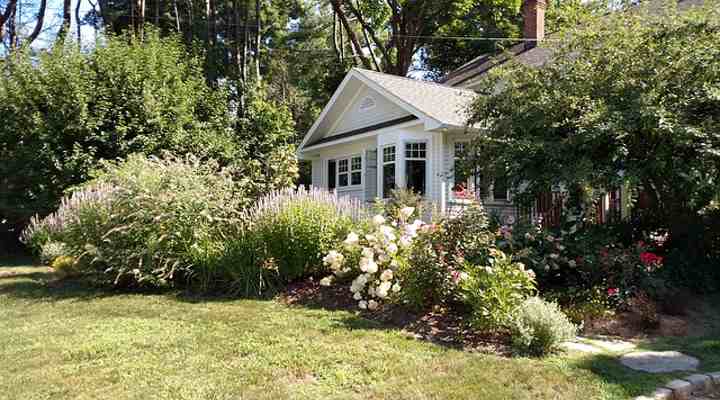
Small crape myrtles can be grown as shrub borders or as ornamental foundation plants
Small crape myrtle shrubs are perfect for growing along driveways, paths, and planting at the front of the house. The lush green foliage and colorful flowers create colorful borders around your garden. The spectacular crape myrtle floral displays add to the aesthetics of your landscaped garden.
Some of the best miniature crape myrtle shrubs for borders are ‘Delta Blush’ (Lagerstroemia indica ‘Delta Blush’) and ‘Centennial Spirit’ (Lagerstroemia indica ‘Centennial Spirit’).
Crape myrtles grow as colorful background plants
Taller crape myrtle trees are excellent landscaping plants to add greenery, height, and color to front or backyards. You can plant large crape myrtle bushes in front of walls, at the corner of houses, or the back of mixed beds. The long-lasting summer blooms add beauty to gardens and hide any ugly features such as walls or compost bins.
Crape myrtle shrubs are ideal for containers
Miniature crape myrtle shrubs grow well in containers, planter boxes, or large pots. Potted crape myrtle plants are ideal if you live in northern climates as you can bring them indoors in winter. Crape myrtles growing in containers are suitable as patio, deck, yard, or balcony plants.
To care for crape myrtles in containers, you should plant them in well-draining soil and only water when the top half of the potting mix is dry. As with all crape myrtle varieties, keep the plant in full sun to encourage blooming and healthy growth.
Where to Plant Crape Myrtle
Plant crape myrtle shrubs in the sunniest location in your front or backyard. Crape myrtles thrive in plenty of sunshine, where they get at least six hours of sunlight daily. However, it’s good to remember that they can withstand some shade.
You should also plant crape myrtle in a location where the plant’s sizeable crown has room to grow and spread. Some crape myrtles can be wider than they are tall. So, if you want to enjoy the blooming shrubs’ full beauty, grow them in a spot with enough room for their foliage.
When to Plant Crape Myrtle
The best time to plant crape myrtle shrubs is between late fall and early spring. Planting before springtime gives the shrubby plant time to adjust and develop a robust root system. Then in spring, the shrub-like tree can start its vigorous growth. Before planting in the ground, water the roots well.
You can also plant crape myrtles in summer. However, you will need to water the new plant frequently after planting. Plenty of hydration during warm summer weather helps the young plant adjust to its new environment and results in healthy growth.
How Fast Do Crape Myrtles Grow?
Crape myrtles are fast-growing shrubs and trees that can grow at a rate of 1 to 2 ft. (0.3 – 0.6 m) per year. The plant’s rapid growth means these garden shrubs are ideal for developing a colorful garden landscape.
Considering crape myrtle’s growth rate can help to decide on the ideal cultivar for your backyard. For example, say you require a small to medium-sized flowering shrub for your garden. It would be best to choose a Lagerstroemia indica cultivar with a mature height of 8 to 10 ft. (2.4 – 3 m). Any larger crape myrtle plant will mean that you have to prune the plant regularly to control its height.
How to Plant Crape Myrtle
Plant crape myrtle shrubs and trees in a suitable location that has well-draining soil and where the plants get plenty of sunlight.
Here is how to plant crape myrtle:
To plant crape myrtle, dig a hole that is twice the diameter of the pot and only as deep as the pot.
Ease the root ball of the crape myrtle plant from the pot and place the root ball in the hole, making sure it grows at the same depth as in the pot. Fill the remaining space with soil and firmly press the ground around the stem. This helps provide stability for the new shrub.
Thoroughly water the crape myrtle to ensure the roots are well-hydrated. During the first two months, water the plant thoroughly weekly if there is no rain.
Place a 3-inch (7.5 cm) layer of organic mulch around the crape myrtle root base, leaving a few inches clear from the trunk.
How to Choose the Perfect Crape Myrtle for Your Garden
Here are some handy tips on picking the ideal crape myrtle cultivar for growing in your garden.
Crape myrtle colors
Crape myrtle plants are famous for their masses of colorful flowers. You can choose between shrubs that have flowers in purple, white, lavender, and red colors. Many crape myrtle cultivars bloom in various pink shades—from light cherry blossom pinks to dark, almost red-pink shades.
Choosing crape myrtles by size
Crape myrtle shrubs come in various sizes, from small shrubs under 3 ft. (1 m) tall to large bushes that max out at around 30 ft. (9 m). Look for the mature size of the bush or tree to decide the cultivar you want. You can prune crape myrtles, but it’s best to keep pruning to a minimum.
Plant disease-resistant crape myrtles
Look for newer crape myrtle cultivars that are developed to be resistant to disease. Some older cultivars are prone to powdery mildew, especially in hot, humid weather. Disease resistant crape myrtles rarely develop the white powdery stuff on leaves common to some plants.
Crape Myrtle Care
Crape myrtle shrubs and trees are generally easy-care landscaping plants. Here is a handy guide to growing crape myrtle plants in your front or backyard.
How Much Sunshine Do Crape Myrtles Need?
Crape myrtle plants thrive in full sunshine and need at least six hours of sunlight daily. The length of blooming depends on the amount of sun the crape myrtles receive. Although the flowering shrubs can grow in partial shade, they won’t produce as many flowers.
Ideal Soil for Crape Myrtle Trees and Bushes
Crape myrtles thrive in most types of soil as long as the ground drains well. You can plant these shrubs and trees in loamy, sandy, or clay soil. Some organic matter worked into the ground helps to retain moisture and provide nutrients for healthy growth.
It’s important to remember that too much compost will result in lush foliage but fewer flowers. The fact that crape myrtles thrive in poor soils means they are excellent landscaping shrubs and trees for gardens where other plants can’t grow.
How to Water Crape Myrtles in the Garden
Crape myrtle trees and shrubs generally don’t require much watering. Lagerstroemia shrubs are usually drought-tolerant plants that can survive on whatever rainfall they get. During long, hot summers, you should water the shrub whenever the ground dries completely.
A layer of mulch around the crape myrtle root zone can help to prevent moisture loss. However, it’s vital to ensure that the plant’s roots never become waterlogged or sit in soggy ground.
Only young crape myrtle shrubs require weekly watering during the first few months after planting until they become established.
Fertilizing Crape Myrtle Bushes and Trees
Crape myrtles can benefit from balanced fertilizers for trees. Apply a slow-release granular fertilizer once a year when growth starts. Sprinkle the granules over the root zone and about 12” (30 cm) beyond the canopy. However, getting enough sunshine is more important than fertilizing crape myrtles.
A suitable fertilizer for crape myrtles should have an NPK rating like 10-10-10 or 12-4-8. Too much nitrogen (N) encourages too much leaf growth and suppresses blooming.
Pruning Crape Myrtle Trees
Prune crape myrtle trees in early spring to remove dead growth and thin weak stems. To encourage bushy growth, trim off a few inches from the ends of branches so side shoots grow and produce more leaves and flowers.
If you want to grow a crape myrtle tree, prune the lower side branches to encourage upward growth. You should also remove any suckers—shoots growing at the tree’s base—to develop a single-stemmed crape myrtle tree.
To encourage blooming multiple times in the season, deadhead spent flowers. This way, you can enjoy the stunning flowers up until the end of fall.
Pests Affecting Crape Myrtle Growth
Crape myrtles are generally resistant to most garden pests and bugs. The most common problem to afflict the plants are crape myrtle aphids. These tiny yellowish-green sap-sucking insects feed on plant cells and leave behind a sweet, sticky honeydew. This sticky substance encourages black sooty mold on leaves. Also, aphids feeding on young leaves can cause leaf damage and distortion.
To get rid of aphids on crape myrtle plants, use a strong jet of water to remove as many of the greenflies as possible. You could also try introducing beneficial predatory insects to control pest infestations.
Diseases Affecting Crape Myrtle Growth
Older varieties of crape myrtle plants used to be susceptible to powdery mildew. However, newer cultivars rarely have this problem of a powdery white substance that appears on leaves. The good news is that powdery mildew isn’t harmless to the shrubs.
Another crape myrtle disease is leaf spot fungus. Some crape myrtle cultivars are prone to this fungal disease that is caused by warm, wet weather. Unfortunately, it isn’t easy to get rid of this disease without resorting to chemical sprays.
Types of Crape Myrtle Trees
Natchez Crape Myrtle (Lagerstroemia indica x fauriei ‘Natchez’) — This crape myrtle hybrid is a small tree with clusters of white crinkled flowers. ‘Natchez’ crape myrtles grow between 20 and 30 ft. (6 – 9 m) tall.
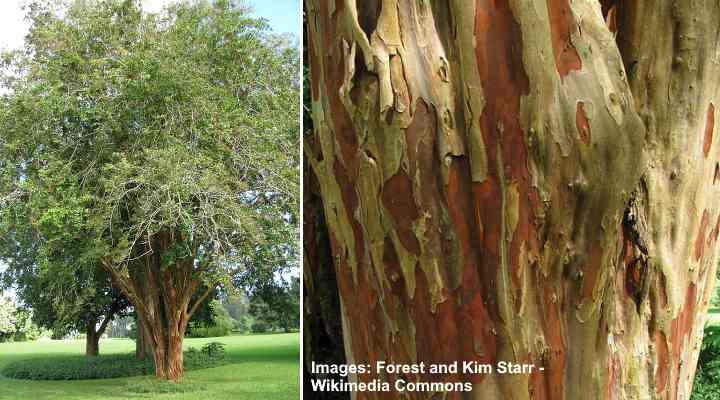
‘Natchez’ crape myrtle
Tuscarora Crape Myrtle (Lagerstroemia indica x fauriei ‘Tuscarora’) — This landscaping tree has beautiful coral-pink flowers that bloom in early summer. ‘Tuscarora’ crape myrtles grow up to 15 ft. (4.5 m) high.
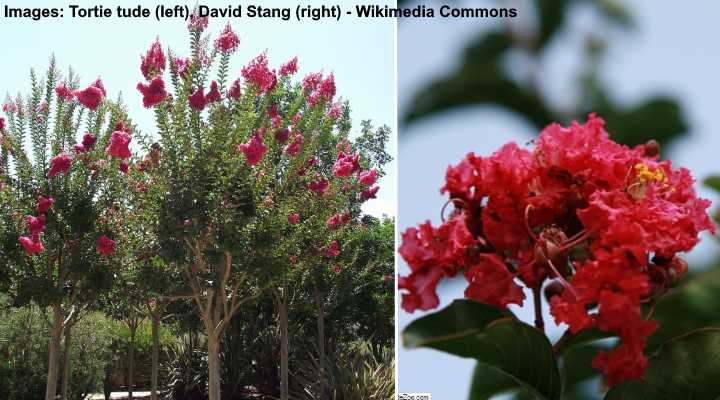
‘Tuscarora’ crape myrtle
Acoma Crape Myrtle (Lagerstroemia indica x fauriei ‘Acoma’) — This dwarf ornamental tree produces stunning white flowers that have the texture of crepe paper. ‘Acoma’ crape myrtles grow around 10 ft. (3 m) tall.
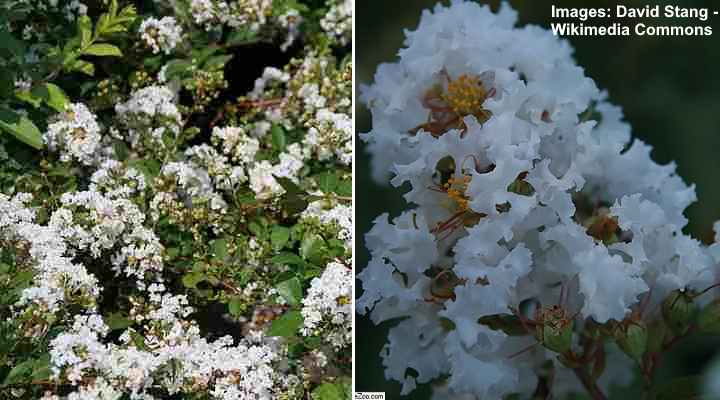
‘Acoma’ crape myrtle
Sioux Crape Myrtle (Lagerstroemia indica x fauriei ‘Sioux’) — ‘Sioux’ crape myrtles produce clusters of ruffled bright pink flowers all summer long. This variety grows between 12 and 15 ft. (3.5 – 4.5 m) in height.
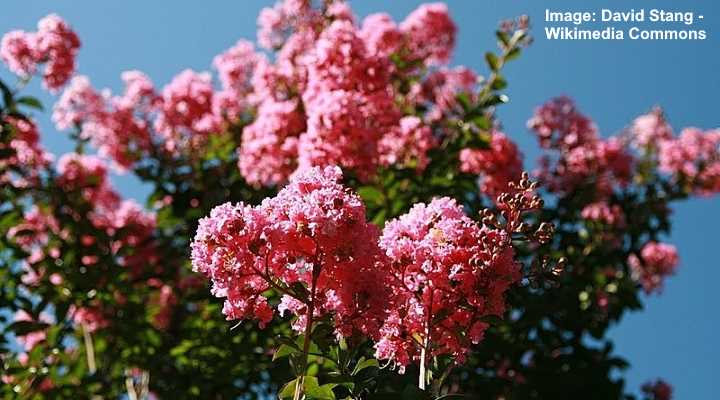
‘Sioux’ crape myrtle
Catawba Crape Myrtle (Lagerstroemia indica ‘Catawba’) — This bushy tree-like shrub produces purple flower panicles in late summer and blooms until the end of fall. ‘Catawba’ crape myrtles grow between 10 and 15 ft. (3 – 4.5 m)
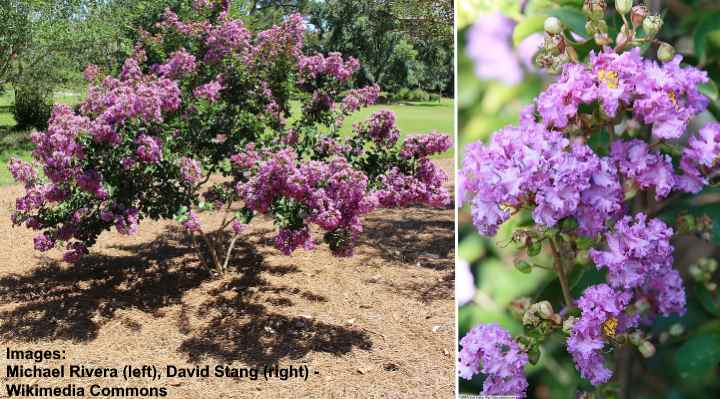
‘Catawba’ crape myrtle
Types of Dwarf Crape Myrtle
Petite Plum Crape Myrtle (Lagerstroemia indica ‘Monum’) — This dwarf crape myrtle produces light red to dark pink clusters of papery flowers. Petite Plum crape myrtles grow up to 5 ft. (1.5 m) tall.
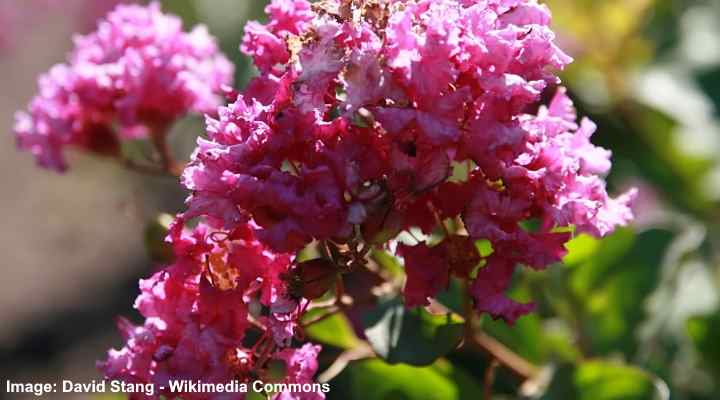
‘Petite Plum’ crape myrtle
Petite Orchid Crape Myrtle (Lagerstroemia indica ‘Monhid’) — This small crape myrtle shrub cultivar blooms with dark pink-purple, crepe-paper flowers. Petite Orchid Lagerstroemia plants grow up to 5 ft. (1.5 m) tall.
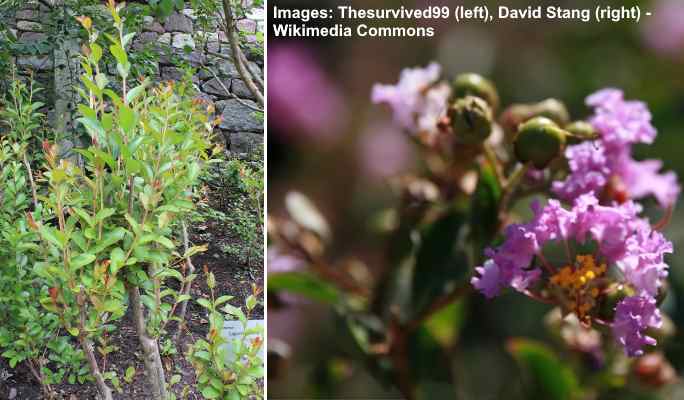
‘Petite Orchid’ crape myrtle
Types of Crape Myrtle Shrubs
Crape Myrtle ‘Delta Blush’ (Lagerstroemia indica ‘Delta Blush’) — This miniature shrub produces light pink summer flowers that hang on drooping branches. ‘Delta Blush’ crape myrtles don’t grow taller than 1.5 ft. (0.5 m).
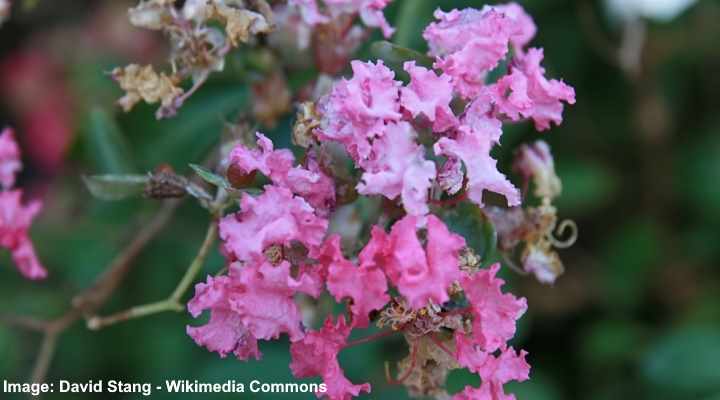
‘Delta Blush’ crape myrtle
Chickasaw Crape Myrtle (Lagerstroemia indica x fauriei ‘Chickasaw’) — This small bushy plant produces a plethora of lavender or pink flowers. ‘Chickasaw’ crape myrtles grow to 2 ft. (0.6 m) tall.
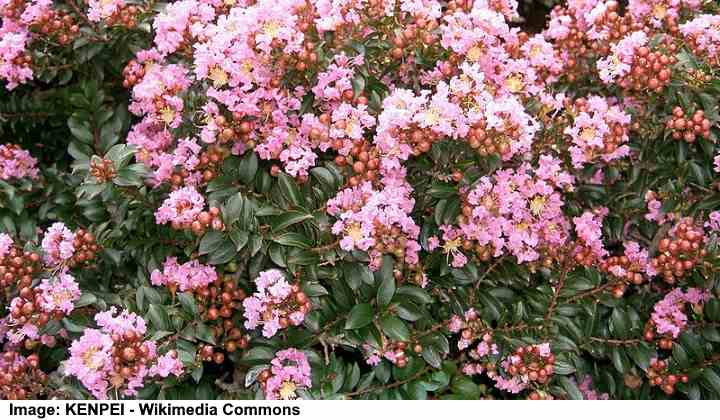
‘Chickasaw’ crape myrtle
Discover many other beautiful types of crape myrtle shrubs and trees (including pictures).
Related articles:
- Types of Viburnum: Shrubs, Trees and Hedges
- Vitex Trees (Chaste Trees): Types, Flowers, Leaves, Care
- Small or Dwarf Flowering Shrubs
